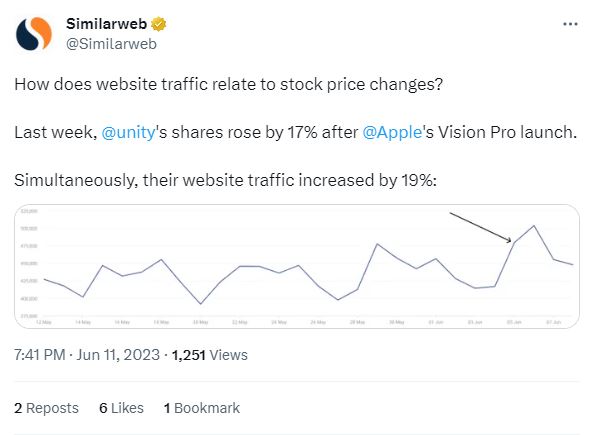
can businesses measure brand loyalty from customer behavior and experience?
Gauging brand loyalty through customer behavior
|
Getting your Trinity Audio player ready... |
Understanding customer behavior is a prerogative for businesses today. A happy customer will no doubt contribute to increased brand loyalty. Customers that are loyal to a brand, in turn, ensure continued profitability.
To understand customer behavior is to provide the best customer experience. A report by IDC states that customer experience has been thrust to the forefront of business priorities as organizations seek to understand, empathize, and relate to what the customer is going through. Asia/Pacific organizations prioritized customer satisfaction almost equally, with operational efficiency as the number one priority.
However, can businesses measure brand loyalty from customer behavior and experience?
According to Uri Snyder, Senior Vice President of APAC at Similarweb, the best way to measure brand loyalty is by building the brand’s strength. With a scope that covers customer trust, brand perception, and market share, Snyder highlights that it is an OK indicator of how a brand is viewed.
He believes that this can then be used to adapt the business strategy. However, traditional methods and models for measuring brand strength take time and consume many resources. Furthermore, they can also return biased results, derailing business success.
“With consumers now having near-unlimited options, they can jump from brand to brand in the blink of an eye. A knee-jerk reaction would be to reorient strategy to up the number of choices offered to customers, but this will only overwhelm them. The key is to focus on trust, which rests on superior data to meet customers where they are,” said Snyder.
For Snyder, brand loyalty today is more complex than it used to be. A McKinsey report indicates that incentivizing loyalty has serious cachet with customers, with 64% stating they would increase the frequency of purchases if a brand offered a loyalty program.
Half said this would be the basis for recommendations to others. Meanwhile, 35% said brands with loyalty programs will have the upper hand in their book. Another 31% even said they would rather fork out more for offerings than turn elsewhere, provided attractive loyalty benefits exist.
“These findings strongly suggest that customer trust and loyalty is no longer a purely transactional relationship. It highlights that standing out requires brands to have accurate, actionable data and analytics to show that they genuinely care. This will foster emotional connections with customers and demonstrate that the business can empathize with customers.
Achieving this requires businesses to leverage accurate measurements quickly. This will raise the organization’s agility and confidence to act on insights swiftly, safe in the knowledge that it is making data-driven decisions,” explained Snyder.

A Tweet on understanding customers.
Why strong brands impact customer behavior
Most businesses today are moving towards omnichannel approaches in their operations. By doing so, enterprises show openness to change as they plan to enhance brand strategies. This begins by embracing new methods for measuring and new data sources.
Snyder believes that brands cultivating an emotional bond with customers need to be able to leverage data to appeal to sentimentality. With fierce competition, gauging how these efforts impact the business is crucial to keeping users engaged.
A study by Similarweb found that keeping customers engaged went hand in hand with brand strength. Companies that knew how to engage with customers on a human level reduced bounce rates and saw an upswing in session durations.
“What this shows is that brands need to be able to tap into what makes their customers tick and move with them as they evolve. For online channels, for example, counting clicks and followers to track brand perception is insufficient. Instead, the business must align with what its customers consider important. Doing this rests on staying lean to move with speed and agility,” he added.
Reaping the benefits
Given the competition brands face today, a strong brand will have a long-term strategy with clear core values that it embodies, especially if it wants to keep customers satisfied. This translates into consistency in customer behavior.
The report also found that strong brands are more likely to have a high share of direct traffic, which can be the gateway to drive conversion rates. It will also position the business to strengthen customer retention through its brand, driving revenue growth and profitability.
“Markets today move at an unprecedented pace. Being able to measure brand strength dynamically is crucial to business success. For companies today, that means incorporating digital metrics and insights to facilitate brand tracking on a whim so that they can make comparisons of their performance with those of their competitors,” mentioned Snyder.
More specifically, to fully understand customer behavior and give them what they want, Snyder suggests that brand campaigns pivot to deliver success by embedding brand messaging in stories that speak directly to what matters to their target audiences.
This will demonstrate how the brand creates value beyond the features of each offering. The impact of this compelling narrative can be assessed through powerful insights that put the microscope on each campaign’s ability to meet strategic criteria.
In conclusion, to fully understand customer behavior, brands must stay ahead of the curve and have performance metrics at their fingertips. This positions companies to be agile and lean in the face of faster and more frequent disruption.
“With consumer behavior and trends more fluid than ever, it is counter-intuitive – not to mention costly – for businesses to deprive themselves of on-demand insights. Unfortunately, legacy systems and traditional approaches do not empower this.
In the digital-first era, brand strategy success rests on being able to count on a slick, modern approach to measuring brand strength. Otherwise, the business can forget about keeping pace with competitors in an increasingly complex business landscape,” concluded Snyder.
READ MORE
- Safer Automation: How Sophic and Firmus Succeeded in Malaysia with MDEC’s Support
- Privilege granted, not gained: Intelligent authorization for enhanced infrastructure productivity
- Low-Code produces the Proof-of-Possibilities
- New Wearables Enable Staff to Work Faster and Safer
- Experts weigh in on Oracle’s departure from adland


